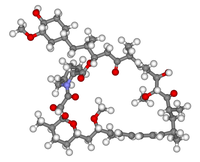
Photo from wikipedia
ABSTRACT Currently, particular focus is placed on the implication of autophagy in a variety of human diseases, including cancer. Discovery of small-molecule modulators of autophagy as well as their potential… Click to show full abstract
ABSTRACT Currently, particular focus is placed on the implication of autophagy in a variety of human diseases, including cancer. Discovery of small-molecule modulators of autophagy as well as their potential use as anti-cancer therapeutic agents would be of great significance. To this end, a series of curcumin analogs previously synthesized in our laboratory were screened. Among these compounds, (3E,5E)-3-(3,4-dimethoxybenzylidene)-5-[(1H-indol-3-yl)methylene]-1-methylpiperidin-4-one (CA-5f) was identified as a potent late-stage macroautophagy/autophagy inhibitor via inhibiting autophagosome-lysosome fusion. We found that CA-5f neither impaired the hydrolytic function nor the quantity of lysosomes. Use of an isobaric tag for relative and absolute quantitation (iTRAQ)-based proteomic screen in combination with bioinformatics analysis suggested that treatment of human umbilical vein endothelial cells (HUVECs) with CA-5f for 1 h suppressed the levels of cytoskeletal proteins and membrane traffic proteins. Subsequent studies showed that CA-5f exhibited strong cytotoxicity against A549 non-small cell lung cancer (NSCLC) cells, but low cytotoxicity to normal human umbilical vein endothelial cells (HUVECs), by increasing mitochondrial-derived reactive oxygen species (ROS) production. Moreover, CA-5f effectively suppressed the growth of A549 lung cancer xenograft as a single agent with an excellent tolerance in vivo. Results from western blot, immunofluorescence, and TdT-mediated dUTP nick end labeling (TUNEL) assays showed that CA-5f inhibited autophagic flux, induced apoptosis, and did not affect the level of CTSB (cathepsin B) and CTSD (cathepsin D) in vivo, which were consistent with the in vitro data. Collectively, these results demonstrated that CA-5f is a novel late-stage autophagy inhibitor with potential clinical application for NSCLC therapy. Abbreviations: 3-MA, 3-methyladenine; ANXA5, annexin A5; ATG, autophagy related; CA-5f, (3E,5E)-3-(3,4-dimethoxybenzylidene)-5-[(1H-indol-3-yl)methylene]-1-methylpiperidin-4-one; CQ, chloroquine; CTSB, cathepsin B; CTSD, cathepsin D; DMSO, dimethyl sulfoxide; DNM2, dynamin 2; EBSS, Earle’s balanced salt solution; GFP, green fluorescent protein; HCQ, hydroxyl CQ; HEK293, human embryonic kidney 293; HUVEC, human umbilical vein endothelial cells; LAMP1, lysosomal associated membrane protein 1; LC-MS/MS, liquid chromatography coupled to tandem mass spectrometry; LDH, lactic acid dehydrogenase; LMO7, LIM domain 7; MAP1LC3B/LC3B, microtubule associated protein 1 light chain 3 beta; NAC, N-acetyl cysteine; MYO1E, myosin IE; NSCLC, non-small cell lung cancer; PARP1, poly(ADP-ribose) polymerase 1; PI, propidium iodide; RFP, red fluorescent protein; ROS, reactive oxygen species; SQSTM1, sequestosome 1; TUNEL, terminal deoxynucleotidyl transferase-mediated dUTP nick-end labeling.
Journal Title: Autophagy
Year Published: 2019
Link to full text (if available)
Share on Social Media: Sign Up to like & get
recommendations!